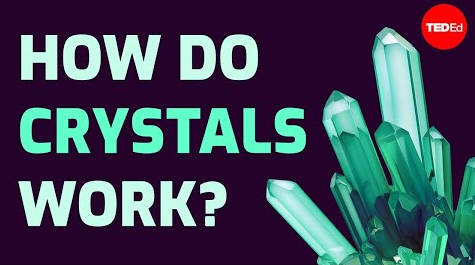Deep beneath the geysers and hot springs of Yellowstone Caldera lies a magma chamber produced by a hot spot in the earth's mantle.
在黄石公园的间歇喷泉和温泉中,有一个由地壳中的热点形成的岩浆室。
As the magma moves towards the Earth's surface, it crystallizes to form young, hot igneous rocks.
当岩浆向地球表面移动时,它结晶形成年轻、炽热的火成岩。
The heat from these rocks drives groundwater towards the surface.
这些岩石的热量将地下水推向地表。
As the water cools, ions precipitate out as mineral crystals,
当水冷却时,离子以矿物晶体方式沉淀出来,
including quartz crystals from silicon and oxygen, feldspar from potassium, aluminum, silicon, and oxygen, galena from lead and sulfur.
包括硅和氧组成的石英晶体,钾、铝、硅和氧组成的长石、铅和硫组成的硫化铅。
Many of these crystals have signature shapes -- take this cascade of pointed quartz, or this pile of galena cubes.
许多晶体都有标志性的形状--比如瀑布般的尖石英或堆状硫化铅立方体。
But what causes them to grow into these shapes again and again?
但是,什么原因导致它们一次次长成这样的形状呢?
Part of the answer lies in their atoms. Every crystal's atoms are arranged in a highly organized, repeating pattern.
部分原因就在于它们的原子。每类晶体的原子都按高度有序的模式重复排列。
This pattern is the defining feature of a crystal, and isn't restricted to minerals
这就是晶体的标志性特征,这种模式并非仅限于矿物,
sand, ice, sugar, chocolate, ceramics, metals, DNA, and even some liquids have crystalline structures.
沙、冰、糖、巧克力、陶瓷、金属、DNA,甚至某些液体也有晶体结构。
Each crystalline material's atomic arrangement falls into one of six different families:
晶体材料的原子排列分为六个不同系列:
cubic, tetragonal, orthorhombic, monoclinic, triclinic, and hexagonal.
立方体、正方三八面体、斜方晶体、单斜晶体、三斜晶体和六方晶体。
Given the appropriate conditions, crystals will grow into geometric shapes that reflect the arrangement of their atoms.
在适当的条件下,晶体会长成反映其原子排列的几何形状。
Take galena, which has a cubic structure composed of lead and sulfur atoms.
以铅、硫原子组成立方结构的硫化铅为例。
The relatively large lead atoms are arranged in a three-dimensional grid 90 degrees from one another,
相对较大的铅原子按彼此呈90度的三维网格排列,
while the relatively small sulfur atoms fit neatly between them.
而相对较小的硫原子正好能塞进铅原子之间。
As the crystal grows, locations like these attract sulfur atoms, while lead will tend to bond to these places.
随着晶体的生长,这些铅原子的位置会吸引硫原子,铅原子易于结合到这些硫原子周围。
Eventually, they will complete the grid of bonded atoms.
最终,他们将完成粘结原子的网格排列。
This means the 90 degree grid pattern of galena's crystalline structure is reflected in the visible shape of the crystal.
也就是说,硫化铅90度网格图案的晶体结构反映在晶体的可见形状中。
Quartz, meanwhile, has a hexagonal crystalline structure.
而石英则是有六方晶体结构。
This means that on one plane its atoms are arranged in hexagons.
也就是说,在一个平面上,原子按六边形排列。

In three dimensions, these hexagons are composed of many interlocking pyramids made up of one silicon atom and four oxygen atoms.
在三维中,这些六边形由许多互锁金字塔组成,每个金字塔由1个硅原子和4个氧原子组成。
So the signature shape of a quartz crystal is a six-sided column with pointed tips.
因此,石英晶体的标志性形状是尖顶六面体。
Depending on environmental conditions, most crystals have the potential to form multiple geometric shapes.
根据环境条件,多数晶体可能形成多个几何形状。
For example, diamonds, which form deep in the Earth's mantle,
例如,在地球地壳深处形成的钻石
have a cubic crystalline structure and can grow into either cubes or octahedrons.
具有立方晶体结构,也可以长成立方体或八面体。
Which shape a particular diamond grows into depends on the conditions where it grows,
特定钻石的生长形状取决于其生长条件,
including pressure, temperature, and chemical environment.
包括压力、温度和化学环境。
While we can't directly observe growth conditions in the mantle,
虽然我们不能直接观察钻石在地壳下的生长条件,
laboratory experiments have shown some evidence that diamonds tend to grow into cubes at lower temperatures and octahedrons at higher temperatures.
但实验室实验的一些证据显示,钻石往往在低温下长成立方体,在较高温度下长成八面体。
Trace amounts of water, silicon, germanium, or magnesium might also influence a diamond's shape.
微量的水、硅、钛或镁也可能影响钻石的形状。
And diamonds never naturally grow into the shapes found in jewelry -- those diamonds have been cut to showcase sparkle and clarity.
钻石永远不会自然长成珠宝中的形状--那些钻石被切割成那样的形状,以最佳展示光彩和净度。
Environmental conditions can also influence whether crystals form at all.
环境条件也会影响晶体形成与否。
Glass is made of melted quartz sand, but it isn't crystalline.
玻璃由熔化的石英沙制成,但它不是固体结晶。
That's because glass cools relatively quickly,
这是因为玻璃冷却相对较快,
and the atoms do not have time to arrange themselves into the ordered structure of a quartz crystal.
原子没有时间将自己安排成石英晶体的有序结构。
Instead, the random arrangement of the atoms in the melted glass is locked in upon cooling.
相反,熔化玻璃中的原子随机排列在冷却过程中被锁定。
Many crystals don't form geometric shapes because they grow in extremely close quarters with other crystals.
许多晶体不能形成几何形状,因为它们与其他晶体一同生长。
Rocks like granite are full of crystals, but none have recognizable shapes.
像花岗岩这样的岩石充满了水晶,但没有一个可以辨认的形状。
As magma cools and solidifies, many minerals within it crystallize at the same time and quickly run out of space.
随着岩浆冷却和凝固,岩浆中的许多矿物同时结晶,并快速塞满了空间。
And certain crystals, like turquoise, don't grow into any discernible geometric shape in most environmental conditions, even given adequate space.
而某些晶体,如绿松石,在大多数环境条件下,不会长成任何可识别的几何形状,即使有足够的空间也不会。
Every crystal's atomic structure has unique properties, and while these properties may not have any bearing on human emotional needs,
每个晶体的原子结构都有独特的特性,虽然这些特性可能对人类情感需求没有任何影响,
they do have powerful applications in materials science and medicine.
但它们确实在材料科学和医学中具有强大的应用。













